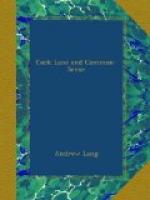A diary of Wodrow’s exists, dating from April 3, 1697, when he was but nineteen years of age. On June 10, 1697, he announces the execution of some witches at Paisley: seven were burned, among them one, Margaret Lang, who accused herself of horrible crimes. The victim of the witches burned in 1697 was a child of eleven, daughter of John Shaw of Bargarran. This family was unlucky in its spiritual accidents. The previous laird, as we learn from the contemporary Law, in his Memorialls, rode his horse into a river at night, and did not arrive at the opposite bank. Every effort was made to find his body in the stream, which was searched as far as the sea. The corpse was at last discovered in a ditch, two miles away, shamefully mutilated. The money of the laird, and other objects of value, were still in his pockets. This was regarded as the work of fiends, but there is a more plausible explanation. Nobody but his groom saw the laird ride into the river; the chances are that he was murdered in revenge,—certain circumstances point to this,—and that the servant was obliged to keep the secret, and invent the story about riding the ford.
The daughter of Bargarran’s successor and heir was probably a hysterical child, who was led, by the prevailing superstition, to believe that witches caused her malady. How keen the apprehensions were among children, we learn from a document preserved by Wodrow. An eminent Christian of his acquaintance thought in boyhood that an old woman looked crossly at him, and he went in dread of being bewitched for a whole summer. The mere terror might have caused fits, he would then have denounced the old woman, and she would probably have been burned. Charles Kirkpatrick Sharpe, in his preface to Law’s Memorialls (p. xcii.), says that Miss Shaw was ‘antient in wickedness,’ and thus accounts for her ’pretending to be bewitched,’ by way of revenging herself




